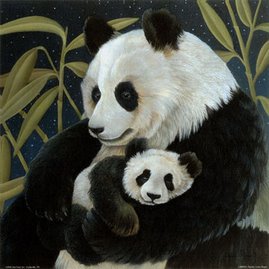They are notoriously picky about their food and suffer from an exceptionally low sex drive. But when it comes to poo, pandas have few peers.
Entrepreneurial Chinese are looking for ways to make a profit from the 44lb (20kg) of excrement produced each day by a single adult male, and help the endangered animals to pay their way.
Officials at Chengdu Giant Panda Breeding Base are working on a scheme to convert the fibre-rich droppings into high-quality paper.
Pandas, which live mainly on a diet of bamboo, lack an efficient digestive tract and absorb less than 20 per cent of what they eat. Staff at the Chengdu base in Sichuan province, southwest China, are talking to local paper mills to find ways of processing a range of products from the panda waste, from greeting cards, bookmarks, notebooks and even fridge magnets.
Jing Jing, Ke Bi, Ya Ya and the 40 or so other pandas living at the Chengdu breeding base produce about 200 tonnes of excrement a year. Thus the pandas may begin to pay for their keep at the research centre, which spends millions of pounds on raising and breeding the rare animals.
Liao Jun, a researcher, said: “If the stools can be used to make souvenirs, we will not only make a profit but also help the environment.” He told The Times that it would be wasteful not to find a way to recycle panda droppings. “We aren’t interested in doing this for the profits but to recycle the waste. We can use the paper ourselves and we can sell whatever is left over.”
The idea was inspired by a visit to the Chiang Mai zoo in northern Thailand, where keepers have found that their two resident pandas have become a gift that gives. In a day-long process of cleaning the faeces, bleaching with chlorine and drying in the sun, the zoo has already earned a profit of £2,000 from panda paper.
Mr Liao said he expected to see items ranging from wrapping paper and paper handkerchiefs to tourist souvenirs such as fans and picture frames made from excrement. Visitors may even be able to gain a hands-on experience with the raw material if the research centre succeeds with plans to move production into a museum.
Miss Zhao, a base official, said: “Panda dung consists mainly of bamboo and fibre. So we find that visitors don’t find it disgusting at all.”

No comments:
Post a Comment